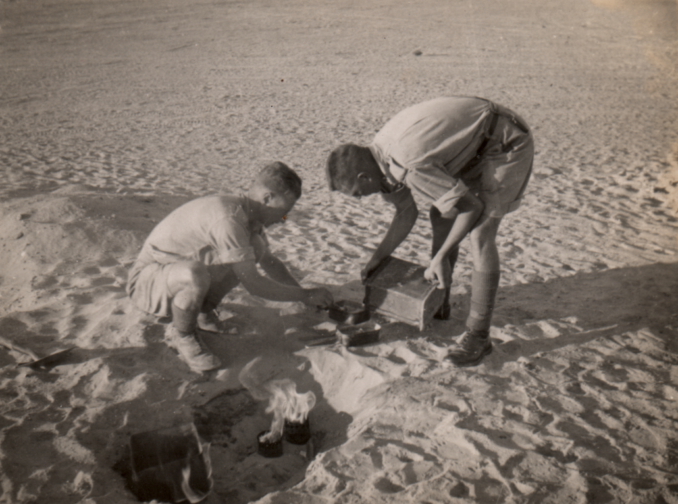
Previously unpublished photo courtesy of DJM’s uncle David, © 2021
With the Axis occupying a smaller and smaller piece of real estate in Tunisia this was the month they would have to surrender, 291,000 of them. There was no way to supply them and no realistic way of evacuating them.
On the 1st US troops captured Hill 609 in Tunisia.
On the 3rd US troops captured Mateur, Tunisia. The Royal Navy began bombarding Pantelleria Island , an Italian owned island off Tunisia. It is still Italian though more famous these days for immigrants from Africa getting a toehold in the EU.
On the 4th The German Luftwaffe evacuation from Tunisia, Italian North Africa was completed. The “Grado” Battalion of the “San Marco” naval infantry regiment of Italian Navy was relocated to the regimental headquarters at Bizerte. Tunisia.
On the 6th In Tunisia, British troops captured Tunis and American troops captured Bizerte. The German 15th Panzer Division was effectively wiped out.
On the 7th Allied naval forces began the Operation Retribution blockade, sealing off Tunisia from the sea. This was all that remained of Italian North Africa even though Tunisia had been a French colony. The Italians scuttled captured French minelayer Castor at Bizerte, Tunisia.
On the 8th In Operation BG 6, Italian auxiliary ship Olterra launched three manned torpedoes against Gibraltar, sinking three cargo ships.
On the 9th The “San Marco” naval infantry regiment of Italian Navy surrendered at Bizerte, Tunisia
On the 10th The British 6th Armoured Division cut off German troops at Cape Bon, Tunisia.
On the 12th 105 survivors of the “San Marco” naval infantry regiment of Italian Navy were evacuated from La Galite Island by motor torpedo boats
On the 13th The remaining Axis troops surrendered in Tunisia. For the first time in the war, the British claimed more German prisoners than the number of British captives in Germany. British Royal Navy warships bombarded Pantelleria Island, Italy.
On the 15th British Admiral Andrew Cunningham announced that “the passage through the Mediterranean was clear”, and convoys from Gibraltar to Alexandria, Egypt resumed.
On the 21st RAF Hal Far was bombed by the Axis for the last time
In other news – on the 1st the International Medical Commission completed its investigation on the Katyn Massacre, concluding that the Soviet Union was responsible for the atrocity, on the 4th the body of Glyndwr Michael was buried at the Cemetery of Solitude in Huelva, Spain as Major William Martin of the British Royal Marines, on the 9th Oberleutnant Heinrich Schmitt of 10/NJG3 defected to the United Kingdom in the new Junkers Ju 88R nightfighter to the delight of Professor Reginald V. Jones, the British electronics expert, whose team were finally able to examine the German FuG 202 Lichtenstein BC radar equipment, on the 14th British Mosquito reconnaissance aircraft photographed a German rocket at Peenemünde, Germany; it was estimated to be 38 feet in length and 2 feet in diameter, on the 17th the Möhne and Edersee Dams were breached by a British air attack known as the Dambusters Raid, on the 19th German propaganda chief Joseph Goebbels, the most anti-semitic see you next Tuesday among a host of them, declared Berlin Judenfrei (“Free of Jews”) while in truth, about 2,000 to 3,000 Jews were in hiding in Berlin, while another 18,000 Germans of mixed Jewish heritage were living in Berlin legally.
Finally the Axis had been thrashed in North Africa and shortly the invasion of Sicily would begin, the culmination of this would be Mussolini’s removal from office. It is still a hard road but the end of the Nazis is in sight. As far as Churchill’s “soft underbelly of Europe” idea goes, it proved far to be from soft and in fact quite hard. Another one of Churchill’s strategic errors. I recently read that Winnie wanted to go at the Germans via the Balkans and that this route had been christened “Europe’s armpit”. It would be unseemly to speculate why it was known as the armpit. With lots of mountains in the Balkans, it would have been at least as tough as Italy was to prove.
In the weeks to come, the relationship between the British and American Generals would start to fray. Eisenhower was already in North Africa and his would be the job of welding them together. Montgomery on his own made this a rather difficult task and between him and Patton there was very little love. This led to an unseemly competition to be the first to Palermo when Sicily was invaded. Generals have always been somewhat on the prima donna side since ancient times. The French Generals and Marshals in the Peninsular War were often at loggerheads refusing to do things because it might profit another. There was also discord between the Allied Generals in WW2 with some American ones being antagonistic and no doubt it was the same with the British ones. Montgomery was especially prickly. Eisenhower’s job of leading them and keeping them happy was not an easy one.
The Desert War had lasted from June 1940 to May 1943. For the Germans it was a bit of a sideshow especially since they invaded Russia. For the British it proved how stretched we really were. Both Hitler and Churchill had their pet theories and foibles. Hitler’s were of course far worse than Churchill’s.
© well_chuffed 2023



